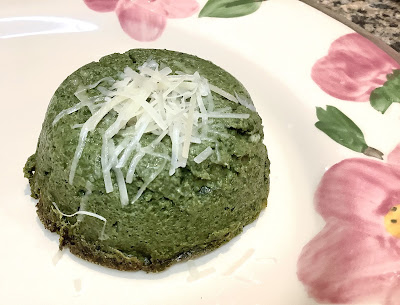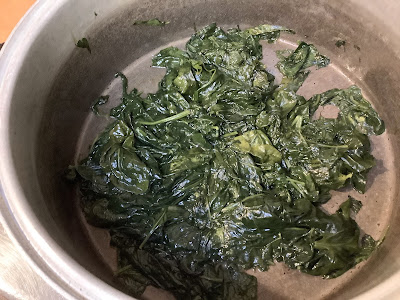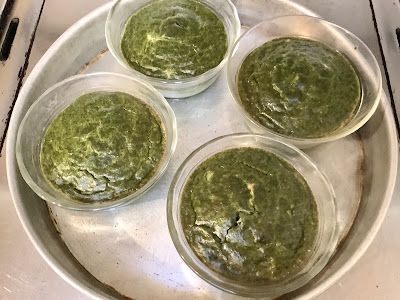
Recipe: Simple spinach timbales make a delicious side dish
 |
|
Spinach timbale is an easy and delicious side dish.
(Photos: Debbie Arrington)
|
Timbales sound fancy (and some are). This simple version shows off one of our favorite spring vegetables – spinach.
We love our spinach on the Left Coast. Jeanne Voltz (a.k.a. Marian Manners), the Los Angeles Times food editor and columnist during the 1950s and '60s, noted that this leafy green was popular with both home cooks and chefs.
“Californians eat spinach with no prodding at all,” she wrote in “The California Cookbook,” a 1970 compilation of Golden State favorites. “The most deluxe restaurants serve enormous quantities of creamed spinach.”
This recipe is a modified version of a throwback. Along with several other spinach recipes, Spinach Timbales were featured as an alternative to ubiquitous creamed spinach in the 1949 “Sunset Cook Book of Favorite Recipes.” (I’ll save that book’s Taxco Spinach-Stuffed Pancakes for another day.)
Timbales got their French name from their shape; it’s derived from the French word for “kettledrum.” Custard cups or other similarly shaped molds work great.
Timbales may have crusts that act as the mold for the rich ingredients inside. The most simple (such as this) are crustless egg custards blended with other ingredients and steamed or baked in a water bath.
Before puréeing, cook your spinach with as little water as possible.
 |
|
Sautéeing the spinach in a little olive
oil is one way to cook it with little water.
|
Spinach timbales
Makes 4 servings
Ingredients:
1 cup cooked spinach, puréed
2 eggs, beaten
½ cup cream
1 scallion, finely chopped (including some green leaves)
¼ cup Parmesan cheese, shredded
1/8 teaspoon hot pepper sauce
1/8 teaspoon pepper
1/8 teaspoon mace or nutmeg
Butter, margarine or non-stick spray
Instructions:
Butter or grease 4 molds or custard cups. Set aside.
Preheat oven to 350 degrees F.
Bring 2 cups water to boil, then turn off heat.
In a mixing bowl, combine puréed spinach, eggs, cream, scallion, Parmesan cheese, hot sauce, pepper and mace or nutmeg until blended. Spoon mixture into prepared molds or custard cups.
Place filled molds or cups in a deep-dish pie pan (or similar pan) and place pan on oven shelf. Carefully fill pan halfway with hot water around the molds or cups (it may not take all 2 cups).
Bake at 350 degrees until the timbales are set and, when tested, a thin-bladed knife comes out clean, about 35 to 40 minutes. Let rest 5 minutes.
To unmold, run a thin-bladed knife along the inside of the mold or cup. Carefully invert over plate.

Comments
0 comments have been posted.Sacramento Digs Gardening to your inbox.
Food in My Back Yard Series
May 6: Maintain soil moisture with mulch for garden success
April 29: What's (already) wrong with my tomato plants?
April 22: Should you stock up on fertilizer? (Yes!)
April 15: Grow culinary herbs in containers
April 8: When to plant summer vegetables
April 1: Don't be fooled by these garden myths
March 25: Fertilizer tips: How to 'feed' your vegetables for healthy growth
March 18: Time to give vegetable seedlings some more space
March 11: Ways to win the fight against weeds
March 4: Potatoes from the garden
Feb. 25: Plant a fruit tree now -- for later
Feb. 18: How to squeeze more food into less space
Feb. 11: When to plant? Consider staggering your transplants
Feb. 4: Starting in seed starting
Sites We Like
Garden Checklist for week of May 4
Enjoy this spring weather – and get gardening!
* Plant, plant, plant! It’s prime planting season in the Sacramento area. Time to set out those tomato transplants along with peppers and eggplants. Pinch off any flowers on new transplants to make them concentrate on establishing roots instead of setting premature fruit.
* Direct-seed melons, cucumbers, summer squash, corn, radishes, pumpkins and annual herbs such as basil.
* Harvest cabbage, lettuce, peas and green onions.
* In the flower garden, direct-seed sunflowers, cosmos, salvia, zinnias, marigolds, celosia and asters. (You also can transplant seedlings for many of the same flowers.)
* Plant dahlia tubers. Other perennials to set out include verbena, coreopsis, coneflower and astilbe.
* Transplant petunias, marigolds and perennial flowers such as astilbe, columbine, coneflowers, coreopsis, dahlias, rudbeckia and verbena.
* Keep an eye out for slugs, snails, earwigs and aphids that want to dine on tender new growth.
* Feed summer bloomers with a balanced fertilizer.
* For continued bloom, cut off spent flowers on roses as well as other flowering plants.
* Add mulch to the garden to maintain moisture. Mulch also cuts down on weeds. But don’t let it mound around the stems or trunks of trees or shrubs. Leave about a 6-inch to 1-foot circle to avoid crown rot or other problems.